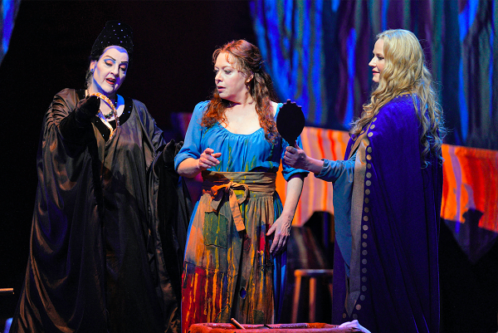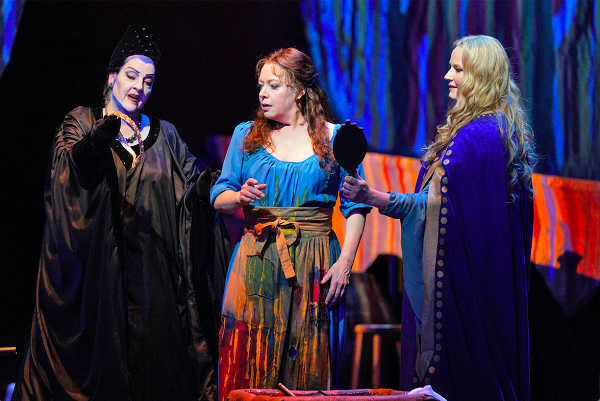 United States R. Strauss, Die Frau ohne Schatten: Soloists, Chorus and Orchestra of San Francisco Opera / Sir Donald Runnicles (conductor). War Memorial Opera House, San Francisco, 10.6.2023. (HS)
United States R. Strauss, Die Frau ohne Schatten: Soloists, Chorus and Orchestra of San Francisco Opera / Sir Donald Runnicles (conductor). War Memorial Opera House, San Francisco, 10.6.2023. (HS)

Production:
Stage director – Roy Rallo
Production and Set design – David Hockney
Costumes – Ian Falconer
Original Lighting – Alan Burrett
Revival Lighting – Justin A. Partier
Choreographer and Dance master – Colm Seery
Chorus director – John Keene
Cast:
Empress – Camilla Nylund
Emperor – David Butt Philip
Barak’s Wife – Nina Stemme
Barak – Johan Reuter
Nurse – Linda Watson
Any mounting of Die Frau ohne Schatten is an Event with a capital E. For San Francisco Opera’s current run, its first since 1989, the company reports residents of 46 states and fourteen countries have bought tickets. It is billed as a ‘bucket list’ thing, akin to performances of Wagner’s Ring and Berlioz’s Les Troyens.
It is easy to understand why. The score requires 105 instrumentalists, 25 principal singers, 54 choristers, 24 child choristers and seven dancers. The five main roles demand singers of Wagnerian power and stamina. There are eight scene changes that happen while the music continues in the nearly four-hour extravaganza.
Aside from all that, this fourth collaboration between composer Richard Strauss and librettist Hugo von Hofmannsthal also challenges audiences with magical characters, a complex story that is dense with symbolism and music that ranges from harsh to sublime.
After experiencing the second of five performances, I can report that not only does all that come together here, it soars. (For those who cannot make it to San Francisco, there will be a paid livestream on 20 June at 7 p.m. PDT that can be watched on demand for 48 hours.)
The David Hockney-designed production, made for Los Angeles Opera but first seen in 1992 at the Royal Opera in London, is a treat for the eyes. Hockney’s evocative shapes move and colors morph, attuned almost preternaturally with the music and the story. A rotating teardrop-shaped centerpiece slides into place to achieve seamless scene changes and provide three-dimensional space for much of the action.
My understanding of the symbolism and fairytale magic elements of the story are, well, imperfect, but I think that puts me on the same page with much of the audience. The shadow in the title refers to the Empress’s lack of one, a stand-in for her inability to conceive a child. Her evil Nurse hatches a plan to steal Barak’s wife’s shadow to satisfy the Emperor.
It is a lot more complicated, but the theme centers on the human desire for love and offspring, and how that can either screw up our lives or make things wonderful. Our current takes on these things have evolved since Strauss and Hofmannsthal put this together as a response to the family dislocations of the First World War.
As in any opera, what matters is the music, and Strauss’s score saves its best for moments when love conquers all and gods become more human. And these humans and gods do go through some steep challenges. There are intentional references to Mozart’s The Magic Flute (both the ordeals of the protagonists and the presence of a witch-like adversary) and Wagner’s Ring (with the chief god’s daughter dabbling with mortals).

This cast, rife with majestic voices, is comprised of singers who know their way around the opera. The best was Camilla Nyland. The Finnish soprano lavished plush, gorgeous sound on the Empress’s music: her melodic phrasing and ability to rise to an effortless top paid dividends at every turn. She could thrill without ever being shrill, and she portrayed the character’s arc from selfishness to generosity with welcome specificity. She also looked ravishing in the Empress’s red-and-gold gown.
As her husband, British tenor David Butt Philip sang at a decibel level slightly lower than the other leads, but he made a regal presence.
Hopes were high for Nina Stemme as the very human, conflicted wife of Barak, the Dyer. If the Swedish soprano struggled to rein in a tendency toward a hard vocal edge, she lashed out with emotional power. She delivered a riveting character, reflecting frustration, disgust, anger and, eventually, love in equal measure.
Danish baritone John Reuter voiced Barak with polish and careful attention to the way his vocal lines intersect with those of the other characters. He delivered nicely on Barak’s dramatic arc from nebbishy to passionate.
Soprano Linda Watson, who was born and raised in San Francisco, made her long-delayed debut with the company as the villain. The Nurse, the Empress’s companion who tries to lead her into evil complications, is a sort of parallel to Mozart’s Queen of the Night, with fewer high notes but plenty of manipulative guile. She played Barak’s wife in this production when it debuted in Los Angeles three decades ago.
The 20-odd other roles got consistently fine singing and stage presence.
It takes a conductor with tremendous command to pull all this together. San Francisco, for example, got Karl Böhm in 1976 (and expanded the orchestra pit to accommodate the full instrumentation he demanded). Christoph von Dohnányi conducted in 1989. Donald Runnicles, who thrives on wrangling big operas, has triumphed here with several Ring cycles, Les Troyens, John Adams’s Doctor Atomic and Messiaen’s Saint François d’Assise.
He may have achieved a new high with this Frau. The very first notes, a dense sequence of dissonance and Straussian layering, hit us like a storm. It pulsed. It rose to climaxes. It emerged with amazing clarity. And that continued throughout, whether in service of a dramatic dialogue among the singers, a crowd scene or one of the extraordinary interludes that go with the scene changes. Acting principal cellist Thalia Moore made a fine impression with the lovely cello solo in Act I, and concertmaster Kay Stern handled the violin solos in Acts II and III with aplomb.
The jewels of an already gleaming performance were the big moments in Act III, starting with the duet in which Barak and his wife, separated in space, find ways to forgive each other, with superb timing and at least musical intimacy. The long scene in which the Empress finally refuses the Nurse’s evil plan was especially riveting, and the glorious effulgence of brass perorations, mixed choruses and orchestral plushness, as only Strauss can do it, brought the opera to a thrilling close.
Harvey Steiman
